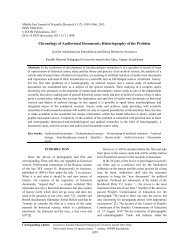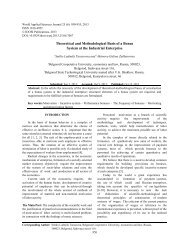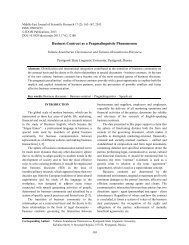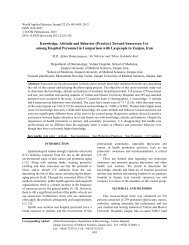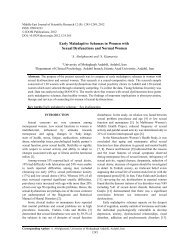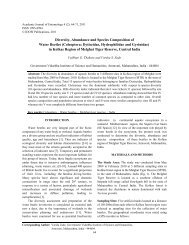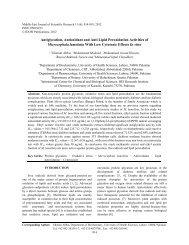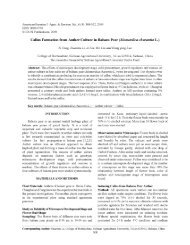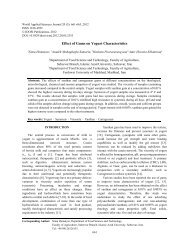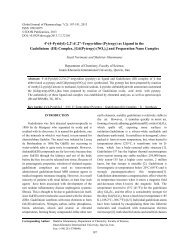Full Text - Idosi.org
Full Text - Idosi.org
Full Text - Idosi.org
You also want an ePaper? Increase the reach of your titles
YUMPU automatically turns print PDFs into web optimized ePapers that Google loves.
Academic Journal of Plant Sciences 6 (3): 127-133, 2013<br />
ISSN 1995-8986<br />
© IDOSI Publications, 2013<br />
DOI: 10.5829/idosi.ajps.2013.6.3.1113<br />
Contributions of Mass Media to the Development of Agricultural Extension<br />
in Ika North East L.G.A of Delta State, Nigeria<br />
1 1 2<br />
Miriam Mgbakor, Omoregie Iyobor and Uzendu Patrick Okezie<br />
1<br />
Department of Agricultural Economics and Extension,<br />
Enugu State University of Science and Technology (ESUT) Enugu, Nigeria<br />
2<br />
Department of Agricultural Engineering and Bioresource,<br />
Enugu State University of Science and Technology (ESUT) Enugu, Nigeria<br />
Abstract: The purpose of this study was to investigate the socioeconomic efforts of mass media on farmers<br />
in Ika North East Local Government Area of Delta State, Nigeria. It was designed to know the kind of services<br />
provided by extension workers to increasing farm output. A total of ninety six (96) farmers were randomly<br />
selected and interviewed. From the tables, simple descriptive statistical tools were used such as: frequency table<br />
and percentage. The findings show that visit of extension workers to farmers were aimed at teaching them<br />
modern technologies, majority of the benefits from extension services were due to usefulness of the<br />
innovations. More efforts are expected from the extension agent to convince the non-adopting farmers to<br />
adhere to their teaching. The major constraints militating against the used mass media were inadequate capital,<br />
language, frequency modulation, power shortage, time of programmes, price of battery and mode of<br />
presentation.<br />
Key words: Mass media Development Agricultural Extension Socio-economic characteristics<br />
INTRODUCTION<br />
transfer, the following factors could be taken into<br />
consideration in programming and dissemination of such<br />
Throughout the world, agriculture is one of the oldest information:<br />
occupations. Although, man has been involved in the<br />
production of food right from Neolithic revolution which The farmers<br />
was associated with the adoption of early farming Their needs and interest<br />
techniques, crop cultivation and the domestication of Format in which information is desired<br />
plant and animals. However, it should be noted that types Their believes and culture<br />
of farming practices then was on subsistence level, which Which method of presentation will serve them better<br />
was characterized by the use of crude implement and poor Justification of the cost of information<br />
inputs.<br />
Early knowledge of agricultural practice was then a Considering the above, it is the focus of this research<br />
collection of experience verbally transmitted from farmer to find out how the potentials of mass media will be<br />
to farmer [1]. It is apparent that adequate and timely exploited for a meaningful agriculture, it is essential for<br />
information is relevant for better understanding of the two reasons:<br />
new programmes. Therefore, one of the primary aims for<br />
stimulating agricultural development is through To allow the necessary increase in food<br />
disseminating relevant information to farmers.<br />
production.<br />
Mass media constitute the main vehicle for wide and To protect and develop the productive potential of<br />
rapid transmission of information to farmers. However, for the natural resources to continue to feed the rapidly<br />
effectiveness of mass media in agricultural information growing population.<br />
Corresponding Authors:<br />
Miriam Mgbakor, Department of Agricultural Economics and Extension,<br />
Enugu State University of Science and Technology (ESUT) Enugu, Nigeria.<br />
Tel: +2347032361922.<br />
127
Acad. J. Plant Sci.,6 (3): 127-133, 2013<br />
It is believed that a well-informed society is an<br />
<strong>org</strong>anized society because government will be more<br />
responsive to their needs and they will be eager to<br />
participate in the nations’ development programme. Radio<br />
is the most responsible and efficient mass medium for<br />
disseminating information required for mobilizing farmers<br />
to participate actively in agricultural extension services.<br />
Though, various communication media have been used to<br />
transmit agricultural information to farmers in Nigeria in<br />
line with the national policy on agriculture, notable among<br />
the media are farm magazine, leaflets, newsletters,<br />
newspapers, pamphlets, radio and television among<br />
others [2]. Radio has been considered as the most<br />
important and most preferred tool of mass communication<br />
in Nigeria [3]. Statistics have shown that radio receivers<br />
are at least ten times more common than TV set in<br />
developing countries and is the only means of information<br />
for two third of people living in rural Nigeria. In addition,<br />
radio is listened to by 80% of people living in developing<br />
countries every week, reaching people isolated by<br />
language geography, conflict, illiteracy and poverty [4].<br />
Since majority of the farmers live in the rural areas, it is<br />
necessary therefore, to understand the situation and<br />
conditions surrounding their farming environment.<br />
The success of agricultural development programmes<br />
in developing countries largely depends on the nature<br />
and extent of use of mass media in mobilization of people<br />
for development. The planners in developing countries<br />
realize that the development of agricultural extension<br />
could be hastened with the effective use of mass media.<br />
Radio and Television have been acclaimed to be the<br />
most effective media for diffusing scientific knowledge to<br />
the masses. In the study area where literacy level is low,<br />
the choice of communication media is of vital importance.<br />
In this regard, the television and radio are significant, as<br />
they transfer modern agricultural technology to literate<br />
and illiterate farmers alike even in interior areas, within<br />
short time to enlighten farmers on the use of various<br />
technologies to boost agricultural development. The<br />
farmers can easily understand the operations, technology<br />
and instruction through the radio.<br />
The mass media have a vital role to play in the<br />
communication of agricultural information among the<br />
literate farmers. Increasing rate of literacy in the country<br />
offers new promises and prospects for utilizing print<br />
medium as a means of mass communication. The print<br />
media widened the scope of communication. It is cheap<br />
and people can afford it and read them at their<br />
convenience. It is a permanent medium in that the<br />
message are imprinted permanently with high storage<br />
value which makes them suitable for reference and<br />
research.<br />
[5], identified that rural farmers are ready for<br />
information but the prevalent problem is non-availability<br />
of or access to some of the information sources.<br />
It is also obvious that most rural areas in Nigeria<br />
especially the study area have no electricity, thus such<br />
media services as Television services do not get to them<br />
even when they can afford to buy one.<br />
The need to incorporate the rural farmers in decisionmaking<br />
is a welcome idea in order to reduce their<br />
indifference towards issues that affect them. This is<br />
because; they are likely to oppose decisions which they<br />
feel are imposed on them and hence mass media should be<br />
given the opportunity to play their vital role of explaining<br />
the principles and activities of government development<br />
programmes as well as agricultural projects in practical<br />
terms.<br />
Objectives of Study: The general objective of this study<br />
was to examine the contribution of mass media to the<br />
development of agricultural extension in Ika North East<br />
Local Government Area of Delta State. The specific<br />
Objectives were to:<br />
describe the socio-economical characteristics of the<br />
farmers reached with agricultural information through<br />
the radio and television;<br />
determine the relationship between farmers level of<br />
education and their use of mass media;<br />
identify the mass media mostly used by farmers;<br />
find out the most effective mass media for the<br />
farmers;<br />
identify the problems encountered by farmers in<br />
using the mass media, advice on the best process to<br />
disseminate information to the farmers in the study<br />
area based on the research findings;<br />
give recommendations based on the research<br />
findings.<br />
Methodology<br />
Area of Study: The study area was Ika North East Local<br />
Government Area of Delta State, Nigeria. The local<br />
government is currently one of the twenty five (25) local<br />
government areas of the state. The Ika speaking people<br />
are found in the North West of Delta State. They share<br />
border in the West with Edo people, in the North with the<br />
Ishan people and East with the Aniocha people and in the<br />
South with the Ukwani people.<br />
128
Acad. J. Plant Sci.,6 (3): 127-133, 2013<br />
Ika people are mainly found in two local government the major food crops cultivated by the farmers, their<br />
areas; Ika North and Ika South Local Government Areas, perceptions on the sources of information for the<br />
both are created in 1991 from the parent Ika Local adoption of improved technologies and the effectiveness<br />
Government Area of Delta State. Ika South and Ika North of the source and the problems they encounter. The<br />
East Local Government Area occupy a land area of 117.45 respondents were asked to indicate the perception of the<br />
square kilometer [6]. With a total population of about source of information and also the contributions of mass<br />
24,000 people, Ika North East Local Government Area is media agencies and also their perception on the<br />
made up of seven communities: Owa Oyibu, Owa effectiveness of these information dissemination for<br />
Alizomor, Owa Alidnma, Owa Ufie, Owa Aliro, Owa Nta agricultural development in Ika North East Local<br />
and Owa Eke. The local government area has its Government Area of Delta State using a four (4) point<br />
headquarters at Owa-Oyibu town. The mainstay of the scale with options as follows: very Effective, Effective,<br />
people of Ika North East local government area is farming Ineffective and Very Ineffective.<br />
and palm wine tapping.<br />
Farm holding in the area are relatively small and Data Analysis: Data was being analyzed using simple<br />
fragmented because of the traditional system of land statistical tool such as frequency counts and percentages<br />
ownership coupled with the limited availability of farmland tables.<br />
relative to the population of the area. Yam cultivation<br />
involving mix cropping with cassava, maize, cocoyam with<br />
RESULTS AND DISCUSSIONS<br />
palm wine tapping are practised in the area. The<br />
agricultural activity of the people is particularly assisted The study investigated the contributions of mass<br />
by some agricultural development projects established in media to the development of agricultural extension in Ika<br />
the area.<br />
North East Local Government Area of Delta State, using<br />
The local government has a population estimate of simple descriptive statistical tool such as: frequency and<br />
183,657 persons [7]. percentage tables. Out of the one hundred and twenty<br />
(120) respondents chosen, ninety six (96) of them<br />
Sampling Techniques: Since there were few registered responded to the questionnaire and interview carried out.<br />
farmers under the local government. The technique that Socio-economic characteristics of the respondents<br />
was used in this study was a multi-staged random discussed are: sex, educational level, age, farm size and<br />
sampling techniques and it was used to select the marital status.<br />
respondents for the study. The first stage involved four Table 1 above shows that 80% of the respondents are<br />
communities, which was randomly selected from the males while 20% were females. This result does not mean<br />
seven communities that made up the local government. that males were involved in farming more than females,<br />
The second involved the farmers, thirty farmers were but it was a reflection of the custom and tradition of the<br />
randomly selected from each of the four communities in area where males serve as heads of households and<br />
the study area to make a total of one hundred and twenty landowners who go into farming except in few cases<br />
(120) farmers. where a man dies and his widowed wife serve as the head<br />
of the household.<br />
Data Collection: The instrument that was used for the Table 2 shows that 27% of the respondents had no<br />
study was a validated structured interview schedule. The formal education, 37% attended primary school, 22% had<br />
literate farmers responded to questionnaires, while an secondary education while 12% had post secondary<br />
interview schedule was <strong>org</strong>anized for those farmers whom education. This result shows that 73% of the respondents<br />
can neither read nor write.<br />
had one level of formal education or the other and can<br />
The instrument was administered in different therefore be said to be relatively literate.<br />
locations in the study area to reflect the different Table 3 shows that 7% of the respondents are under<br />
communities. Less enlightened farmers were assisted in 20 years of age. This percentage may have represented<br />
the collection of data.<br />
the number of respondents who took up their father’s<br />
The schedule contained relevant sections to provide farmland in their young age upon the death of their<br />
information on their socio-economic characteristics, the fathers, 15% belong to the age range of 20-30 and 59%<br />
improved farm practices disseminated and adopted by the belong to the age range of 31-50 while 19% are<br />
farmers, type of farm activities engaged by the farmers, above 50 years of age. This result revealed that 74% of<br />
129
Acad. J. Plant Sci.,6 (3): 127-133, 2013<br />
Table 1: Distribution of Respondents based on their Sex<br />
Sex Frequency Percentage (%)<br />
Male 77 80.0<br />
Female 19 20.0<br />
Total 96 100<br />
Source: Field Survey, 2010<br />
Table 2: Distribution of Farmers According to their Educational Level<br />
Sex Frequency Percentage (%)<br />
No formal education 26 27.0<br />
Primary education 37 39.0<br />
Secondary education 21 22.0<br />
Post secondary education 12 12.0<br />
Total 96 100<br />
Source: Field Survey, 2010<br />
Table 5: Distribution of Respondents according to their Marital Status<br />
Marital Status Frequency Percentage (%)<br />
Single 6 6.0<br />
Married 90 94.0<br />
Total 96 100<br />
Source: Field Survey, 2010<br />
Table 6: Distribution of Respondents according to their Religion<br />
Religion Frequency Percentage (%)<br />
Muslim 5 5.0<br />
Traditional 8 8.0<br />
Hinduism 0 0.0<br />
Christian 83 87.0<br />
Total 96 100<br />
Source: Field Survey, 2010<br />
Table 3: Distribution of Respondents according to their Age<br />
Age (years) Frequency Percentage (%)<br />
Under 20 7 7.0<br />
20-30 14 15.0<br />
31-50 57 59.0<br />
Above 50 18 19.0<br />
Total 96 100<br />
Source: Field Survey, 2010<br />
Table 7: Types of Programme Listened to or Viewed or Read by Farmers<br />
Types of Programme Frequency Percentage (%)<br />
Input supply and distribution 72 75.0<br />
Variety of trials 0 0<br />
Chemical application 0 0<br />
Policy announcement 24 25.0<br />
Total 96 100<br />
Source: Field Survey, 2010<br />
Table 4: Distribution of Respondents according to their Farm Size<br />
Size of Farm (ha) Frequency Percentage (%)<br />
Less than one hectare 6 6.0<br />
Studies on the marital status of the respondents<br />
revealed that 94% were married. Hence, majority of the<br />
1-2 hectares 39 41.0 respondents were settled family farmers who would most<br />
3-4 hectares 28 29.0 likely be serious with their farm work while 6% were<br />
Above 4 hectares 23 24.0 single. Studies were also carried out on the various<br />
Total 96 100 occupations of the people. All of the farmers who served<br />
Source: Field Survey, 2010<br />
as respondents in the study area had farming as their main<br />
occupation, while some had other occupations such as<br />
trading, teaching, civil service as secondary occupation.<br />
Greater majority were entirely dependent on farming.<br />
Hence, they are most likely to be serious with their farm<br />
work and should take matters affecting their farming<br />
seriously.<br />
Table 6 shows that 87% of the respondents belong to<br />
Christian religion while 0% of the respondents belong to<br />
Hindus religion.<br />
the respondents who responded to the questionnaire<br />
belong to the age range of 20-50 years, so this means that<br />
the respondents involved in the study are within the<br />
middle group and hence should be very active and<br />
desirous of information capable of improving their<br />
standard of living and farm work.<br />
Studies on the size of farmland maintained by farmers<br />
as presented on table 4 above revealed that 29% had 3 to<br />
4 hectares, while 6% of the respondents involved in the<br />
study had farm holdings less than one hectare. This result<br />
shows that the respondents involved in the study are<br />
mostly small-scale farmers this is also a reflection of the<br />
complex land tenure system in the area, land is either<br />
owned in fragment by families or households as assets<br />
inherited from their late father’s with large family sizes,<br />
individual farm sizes are therefore drastically reduced.<br />
The Farmers’ Use of Mass Media for Agricultural<br />
Information: In response to question on the various<br />
purpose for which respondents listened to or viewed or<br />
read agricultural programmes on the mass media, result on<br />
table 7 above was obtained. Great percentages of the<br />
respondents were on input supply and distribution (75%)<br />
announcement on policy announcements (25%).<br />
130
Acad. J. Plant Sci.,6 (3): 127-133, 2013<br />
Table 8: Distribution of Farmers Based on Sources of Information on New Table 12: Distribution of Farmers according to their Purpose of Mass Media<br />
Farm Practice<br />
Awareness of New Farm Practices Frequency Percentage (%)<br />
Types of Program<br />
Agricultural information<br />
Frequency<br />
81<br />
Percentage (%)<br />
85.0<br />
Through extension agent 35 37.0 Entertainment 8 8.0<br />
Through friends 10 10.0 News 4 4.0<br />
Through radio/television 15 16.0 Other news 3 3.0<br />
Through fellow farmers 25 26.0 Total 96 100<br />
Through neighbors 6 6.0<br />
Source: Field Survey, 2010<br />
Through discussion in group 5 5.0<br />
Total 96 100 Table 12: Distribution of Respondents Based on acquired Innovation<br />
Source: Field Survey, 2010<br />
through the mass media<br />
Table 9: Distribution of Farmers to their view on how Mass Media affect<br />
their Farming Practices<br />
Types of Program Frequency Percentage (%)<br />
Crop production 75 78.0<br />
Animal production 7 7.0<br />
Crop processing 1 1.0<br />
Producer marketing 13 14.0<br />
Total 96 100<br />
Source: Field Survey, 2010<br />
Table 10: Distribution of Farmers according to their use of the mass media<br />
Mass Media Frequency Percentage (%)<br />
Radio 78 81.0<br />
Television 13 14.0<br />
Prints 5 5.0<br />
Total 96 100<br />
Source: Field Survey, 2010<br />
Table 11: Distribution of Available Media to the farmers<br />
Available Media Frequency Percentage (%)<br />
Radio 83 87<br />
Television 8 8<br />
Print 5 5<br />
Total 96 100<br />
Source: Field Survey, 2010<br />
This result supports the problem identified by [5] that<br />
rural farmers are ready for information but lack access to<br />
some of the information sources.<br />
Analysis in table 8 shows that 35% of respondents<br />
became aware of new farm practices through extension<br />
agents, 10% became aware through friends, 15% became<br />
aware through radio and television, 25% through<br />
neigbours, while 5% became aware through discussion in<br />
social group. It therefore shows that sources of<br />
information to the farmers were mostly through extension<br />
agents in the teaching of recommendation technologies.<br />
Acquired Innovation Frequency Percentage (%)<br />
Planting techniques 68 71<br />
Fertilizer application 26 29<br />
Total 96 100<br />
Source: Field Survey, 2010<br />
Table 13: Distribution of Respondents based on their Access to the Media<br />
Mass Media Frequency Percentage (%)<br />
Radio 86 90.0<br />
Television 9 9.0<br />
Prints 1 1.0<br />
Total 96 100<br />
Source: Field Survey, 2010<br />
From the studies carried out to find the farmers’<br />
views on how the mass media system affect their farming<br />
practices, 78% agreed that the mass media affected their<br />
crop production, while 1% accepted that the media<br />
affected their crop processing.<br />
Table 10 shows that 81% of the respondents use<br />
radio to acquire agricultural information and 5% uses it to<br />
acquire agricultural information.<br />
The Mass Media Mostly Used by Farmers as Source of<br />
Agricultural Information: Analysis in table 11 shows<br />
that Radio was available to 87% of the respondents,<br />
television was available to 8 percent of the respondents,<br />
while the prints was available to 5% of the respondents.<br />
Table 12 shows that 85% use the mass media for<br />
agricultural information only while 3 percent use it for<br />
other news.<br />
Analysis in table 12 shows that 71% acquire planting<br />
techniques innovation through the media while 29%<br />
acquired fertilizer application innovation through the<br />
media.<br />
The Most Effective Mass Media for the Farmers: Table 13<br />
shows that out of the 96 respondents that has access to<br />
the radio, 90% are using it as source of agricultural<br />
131
Acad. J. Plant Sci.,6 (3): 127-133, 2013<br />
Table 14: Distribution of Respondents based on their Most Effective Media<br />
Mass Media Frequency Percentage (%)<br />
Radio 81 94.0<br />
Television 11 12.0<br />
Prints 4 4.0<br />
Total 96 100<br />
Source: Field Survey, 2010<br />
Table 15: Timing of Agricultural Programmes<br />
Time Frequency Percentage (%)<br />
Morning 7.00-11.00 8 8.00<br />
Afternoon 12.00-3.00pm 0 0<br />
Evening 6.00-7.00pm 88 92<br />
Total 96 100<br />
Source: Field Survey, 2010<br />
Table 16: Distribution of Respondents according to Constraints Militating<br />
the use of Mass Media<br />
Constraint Frequency Percentage (%)<br />
Price of battery 25 26<br />
Frequency modulation 40 42<br />
Power (shortage of power) 15 16<br />
Time of programme 10 10<br />
Language 6 6<br />
Total 96 100<br />
Source: Field Survey, 2010<br />
Table 17: Distribution of Respondents based on the ways of Reducing these<br />
Problems<br />
Ways of Reducing the Problems Frequency Percentage (%)<br />
Provision of electricity 78 82<br />
Favourable time of presentation 9 9<br />
Improved method of presentation 9 9<br />
Total 96 100<br />
Source: Field Survey, 2010<br />
information. On the other hand only 9% of the 96<br />
respondents that had access to television while in the<br />
area of print 1% used it for agricultural information. Radio<br />
was thus the most commonly used media system for<br />
agricultural information.<br />
Table 14 shows that 84% of the respondents agreed<br />
that the radio was very effective, while 4 of the<br />
respondents agreed that the print was the most effective.<br />
Analysis in table 15 shows that 92% preferred<br />
evening (6.00-7.00pm) while 8% of the respondents<br />
preferred morning time (7.00-11.00am). This result agrees<br />
with the view that agricultural programme should be<br />
presented in the evening when farmers might have come<br />
back from their farm work and would he more relaxed and<br />
patient enough to listen to the message attentively.<br />
The Problems Encountered by Farmers: The result of<br />
table 16 shows that frequency modulation affects 42% of<br />
the respondent’s use of the media, while language affects<br />
6% of the respondents use of the media.<br />
The result in table 17 shows that 82% of the<br />
respondents agreed that provision of electricity will<br />
enhance their access and use of mass media, while a<br />
percent agreed that improved method of presentation will<br />
enhance their productivity.<br />
CONCLUSION AND RECOMMENDATIONS<br />
Summary: The result of this study showed that majority<br />
80% of the farmers in Ika North East Local Government<br />
Area of Delta State were males while 20% were females.<br />
The results also revealed that majority of the farmers had<br />
one form of formal education or the other. Although,<br />
majority 39 was primary school attempted who cannot<br />
read or write well. On the age distribution, result showed<br />
that greater percentages (74%) were able-bodied, middleaged<br />
men who should be active in agricultural practices<br />
and who should be desirous of information on agriculture.<br />
The survey also revealed that Radio was the most<br />
widely used mass media system by the farmers with 84.0%<br />
of the farmers who had access to it claiming that they<br />
listened to it for agricultural information. Only 12.00% and<br />
4.00% claimed they use the television and prints<br />
respectively. Again, the use of various media systems<br />
was found to be independent of the socio-economic<br />
characteristics of the farmers, this reveals that farmers<br />
age, sex, marital status, farm size and educational levels do<br />
not affect their use of mass media as source of agricultural<br />
information by the rural farmers.<br />
Conclusion: In order to gainfully exploit the potentials of<br />
the mass media system, the extension service agency<br />
should have to reach the farmers regularly through the<br />
mass media to complement direct contact by extension<br />
agents. The government on the other hand will have to<br />
direct her attention to the use of Television and Radio as<br />
the most effective means of reaching the rural dwellers in<br />
her various developmental programmes. To the media<br />
stations, they will have to improve on their broadcasting<br />
services to achieve effectively. With effective<br />
programming and information dissemination, the impact of<br />
radio and television will be felt by the rural farmers. In this<br />
way, they realize that this media are essential tools for<br />
getting the information they require for increasing their<br />
farm production and productivity.<br />
132
Acad. J. Plant Sci.,6 (3): 127-133, 2013<br />
Recomendations: To promote and ensure the adoption of<br />
REFERENCES<br />
innovations and relevant agricultural information by<br />
farmers in Ika North East Local Government Area, 1. Diamond, J., 2002. Evolution consequences and<br />
government needs to ensure adequate availability of rural future of plant and animal domestication.<br />
infrastructures and facilities so as to enable more of the Nature Magazine, 418: 4-12.<br />
rural farmers to cultivate the habit of utilizing mass media 2. Dare, O., 1990. The role of the Nigeria Mass Media in<br />
as source of agricultural information.<br />
national rural development and transformation.<br />
There is also the need for extension agents to Paper presented at the media forum <strong>org</strong>anized by<br />
increase the use of mass media in disseminating international institute of tropical agriculture (IITA)<br />
information on agricultural to farmers. This is necessitated Ibadan.<br />
by mass media will help in stimulating agricultural 3. Brown, L. et al., 1991. A hand book on Adult<br />
development. Rural farmers’ education by the extension Education for West African. Hutchson and Co. Pub.<br />
agency will also help the farmers appreciate the Ltd. London.<br />
usefulness of the mass media system as sources of 4. Aboyade, Olalimpe, 1997. The provision of<br />
agricultural information.<br />
information for rural development. Ibadan Wemilore<br />
Finally, mass media agencies and the agricultural Press Limited, pp: 15-59.<br />
extension agency should always consider the following 5. Ogionwo, W., 2000. Personal dimension of<br />
factors to ensure effective information dissemination to innovation behaviour. Cambridge Massachusetts<br />
farmers.<br />
Schenkinnah Publishing Company Inc.<br />
The understanding of the target audience, this needs 6. Delta State Government Website, 1999.<br />
and interest, what order to time should the agricultural 7. National Population Commission (NPC), Nigeria.<br />
programmes be presented to ensure greatest impact,<br />
which methods of presented will service them best,<br />
justification of cost, etc.<br />
133



